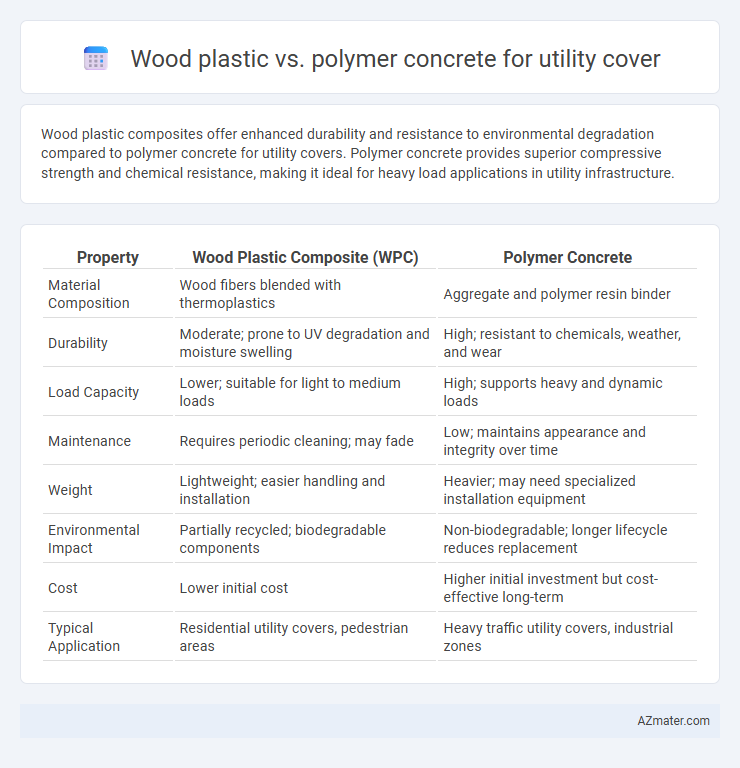Wood plastic composites offer enhanced durability and resistance to environmental degradation compared to polymer concrete for utility covers. Polymer concrete provides superior compressive strength and chemical resistance, making it ideal for heavy load applications in utility infrastructure.
Table of Comparison
| Property | Wood Plastic Composite (WPC) | Polymer Concrete |
|---|---|---|
| Material Composition | Wood fibers blended with thermoplastics | Aggregate and polymer resin binder |
| Durability | Moderate; prone to UV degradation and moisture swelling | High; resistant to chemicals, weather, and wear |
| Load Capacity | Lower; suitable for light to medium loads | High; supports heavy and dynamic loads |
| Maintenance | Requires periodic cleaning; may fade | Low; maintains appearance and integrity over time |
| Weight | Lightweight; easier handling and installation | Heavier; may need specialized installation equipment |
| Environmental Impact | Partially recycled; biodegradable components | Non-biodegradable; longer lifecycle reduces replacement |
| Cost | Lower initial cost | Higher initial investment but cost-effective long-term |
| Typical Application | Residential utility covers, pedestrian areas | Heavy traffic utility covers, industrial zones |
Introduction to Utility Covers: Importance and Materials
Utility covers protect underground infrastructure by providing durable, load-bearing access points essential for maintenance and safety. Wood plastic composites offer lightweight, corrosion-resistant solutions with environmental benefits, while polymer concrete delivers superior strength, chemical resistance, and longevity under heavy loads. Selecting the right material depends on factors like load requirements, environmental exposure, and lifecycle costs to ensure optimal performance and durability.
Overview of Wood Plastic Composite Utility Covers
Wood Plastic Composite (WPC) utility covers are engineered from a blend of natural wood fibers and thermoplastic polymers, offering enhanced durability, corrosion resistance, and lightweight properties ideal for utility applications. Unlike polymer concrete covers, which are known for their high compressive strength and rigidity, WPC covers provide better impact resistance and reduced brittleness, making them suitable for environments with fluctuating loads and moisture exposure. The renewable composition of WPC materials also contributes to sustainability efforts, reducing environmental impact while delivering cost-effective maintenance and longevity in utility cover installations.
Key Features of Polymer Concrete Utility Covers
Polymer concrete utility covers offer superior durability and chemical resistance compared to wood plastic composites, making them ideal for heavy-load applications and harsh environmental conditions. Their high compressive strength and excellent fire resistance enhance safety and longevity, while low porosity minimizes water absorption and prevents damage from freeze-thaw cycles. The non-corrosive and lightweight characteristics simplify installation and reduce maintenance costs, positioning polymer concrete as a premium choice for utility infrastructure.
Durability Comparison: Wood Plastic vs. Polymer Concrete
Polymer concrete utility covers demonstrate superior durability compared to wood plastic composites, exhibiting higher resistance to chemical corrosion, weathering, and heavy load-bearing applications. Wood plastic composites, though moderately durable, tend to degrade over time when exposed to UV radiation and moisture, leading to potential structural weaknesses. The dense and chemically inert nature of polymer concrete ensures prolonged service life and minimal maintenance in demanding utility infrastructure environments.
Weight and Handling Considerations
Wood plastic composite utility covers offer a lightweight alternative, typically weighing 30-50% less than traditional polymer concrete covers, making them easier to handle and install. Polymer concrete covers, while heavier and more cumbersome, provide superior compressive strength and durability, often weighing between 40 to 80 pounds per square foot compared to wood plastic's 20 to 40 pounds. Reduced weight in wood plastic covers enhances worker safety by minimizing lifting strain, whereas polymer concrete's weight may require mechanical assistance during placement.
Resistance to Environmental Factors
Wood plastic composites offer moderate resistance to moisture and UV exposure, making them suitable for utility covers in environments with variable weather conditions. Polymer concrete exhibits superior resistance to chemicals, freeze-thaw cycles, and abrasion, ensuring long-term durability in harsh environmental factors. The choice depends on site-specific exposure to moisture, temperature fluctuations, and chemical stressors for optimal utility cover performance.
Load-Bearing Capacity and Safety Standards
Wood plastic composite utility covers offer moderate load-bearing capacity suitable for pedestrian and light vehicular traffic, meeting general safety standards with resistance to corrosion and impact. Polymer concrete covers provide significantly higher load-bearing capacity, often exceeding 50 kN, making them ideal for heavy traffic areas and compliance with stringent safety regulations such as EN124 Class D400 and above. The superior mechanical strength and durability of polymer concrete ensure enhanced safety performance and longer service life under high-stress urban infrastructure conditions.
Installation and Maintenance Differences
Wood plastic composites (WPC) utility covers offer lightweight installation and require minimal maintenance due to their resistance to rot and corrosion. Polymer concrete covers provide higher load-bearing capacity but demand more precise handling during installation to prevent cracking. Over time, polymer concrete requires occasional sealing to maintain durability, while WPC covers mainly need surface cleaning to preserve appearance and functionality.
Cost Analysis: Initial and Lifecycle Expenses
Wood plastic composites generally offer lower initial costs compared to polymer concrete utility covers, making them attractive for budget-sensitive projects. Polymer concrete, while having a higher upfront investment, provides superior durability and resistance to environmental factors, translating to reduced maintenance and replacement expenses over its lifecycle. Lifecycle cost analysis often favors polymer concrete due to its extended service life and minimal upkeep requirements despite the steeper initial price.
Choosing the Best Material for Utility Covers
Wood plastic composites offer excellent durability, resistance to moisture, and lightweight handling, making them ideal for utility covers in wet or humid environments. Polymer concrete provides superior compressive strength and high load-bearing capacity, suitable for heavy traffic areas requiring robust performance. Selecting the best material depends on project-specific requirements such as environmental exposure, load demands, and maintenance considerations.

Infographic: Wood plastic vs Polymer concrete for Utility cover
 azmater.com
azmater.com